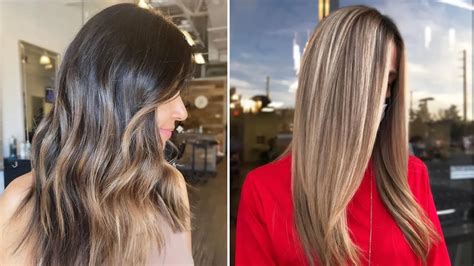Introduction
Balayage and highlights are two popular hair coloring techniques that can add depth, dimension, and style to your locks. But what’s the difference between the two? And how do you know which one is right for you?

Balayage
Balayage is a French word that means “to sweep.” It’s a freehand hair coloring technique that involves painting on lightener to create soft, natural-looking highlights. Balayage is typically done on dry hair, and the lightener is applied in a way that creates a gradual, seamless blend of colors.
Pros of Balayage:
- Natural-looking results: Balayage creates soft, subtle highlights that look like they could have been naturally sun-kissed.
- Low-maintenance: Balayage doesn’t require as much upkeep as traditional highlights. Because the highlights are blended, they grow out more gracefully and don’t need to be touched up as often.
- Versatile: Balayage can be customized to create a variety of looks, from subtle highlights to bolder, more dramatic effects.
Cons of Balayage:
- Can be time-consuming: Balayage is a more time-consuming process than traditional highlights, as it requires the colorist to apply the lightener by hand.
- Can be more expensive: Balayage typically costs more than traditional highlights, as it requires more time and skill to achieve the desired results.
Highlights
Highlights are a more traditional hair coloring technique that involves using foil or plastic wrap to isolate sections of hair and then applying lightener to those sections. Highlights can be placed in a variety of patterns, from fine, subtle highlights to chunky, dramatic streaks.
Pros of Highlights:
- More precise: Highlights give the colorist more control over the placement and intensity of the highlights. This can be beneficial for creating specific looks, such as bold streaks or geometric patterns.
- Can be used to correct color: Highlights can be used to correct uneven hair color or to add warmth or coolness to the hair.
- Less time-consuming: Highlights are typically a less time-consuming process than balayage, as the lightener is applied to isolated sections of hair.
Cons of Highlights:
- Can look artificial: Highlights can sometimes look artificial or unnatural, especially if they are placed too close together or if the lightener is too strong.
- Can damage hair: Highlights can damage the hair if they are not done properly. The lightener can weaken the hair, making it more susceptible to breakage.
- Can be high-maintenance: Highlights require regular touch-ups to keep them looking fresh. As the hair grows out, the highlights will become less visible and may need to be redone every 6-8 weeks.
Which Technique Is Right for You?
The best hair coloring technique for you depends on your individual hair type, desired look, and budget.
- If you want natural-looking highlights that are low-maintenance, balayage is a good choice.
- If you want more precise highlights or if you want to correct color, highlights are a good choice.
- If you have fine hair or if you are on a tight budget, highlights may be a better option than balayage.
Tips for Choosing the Right Hair Colorist
No matter which hair coloring technique you choose, it’s important to choose a qualified hair colorist. A good colorist will be able to assess your hair type and desired look and recommend the best technique for you. They will also be able to apply the lightener correctly and safely to minimize the risk of damage to your hair.
Here are a few tips for choosing the right hair colorist:
- Ask for recommendations from friends or family members.
- Read online reviews of different salons.
- Look for a colorist who has experience with your hair type and desired look.
- Schedule a consultation with the colorist before your appointment to discuss your goals.
Conclusion
Balayage and highlights are both popular hair coloring techniques that can add depth, dimension, and style to your locks. The best technique for you depends on your individual hair type, desired look, and budget. By choosing the right technique and a qualified hair colorist, you can achieve the perfect hair color for you.
